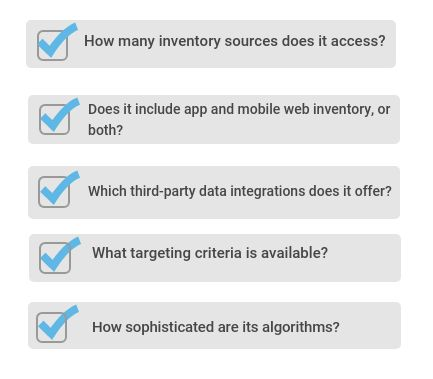Questions to consider when
selecting your DSP
Once you have outlined your marketing objectives for your business, and how you want to achieve them with programmatic advertising, the questions above are a useful guideline to help navigate your selection process in recognizing and choosing the best DSP. But let’s dissect the questions and elaborate on them a little more.
Inventory
In H1 2022, based on the weak users growth of the US, Triwin established preliminary cooperation with WebEye and achieved high-speed growth through our large traffic pool. We assisted Triwin in expanding its partnership network in North and South America, including entry into new markets such as Brazil. At the same time, the number of cooperative products also increased rapidly, realizing a growth cooperation matrix for multiple products and countries.
Reach
A DSP’s reach is as important as inventory quality. So make sure to look for a DSP provider that has connections with high quality exchanges as well as access to global traffic. That’s why it can be also useful to ask about their traffic sources when choosing your DSP.
Efficiency
A DSP with efficient and flexible tools and technology is key to running successful ad campaigns. You want a platform that is easy to navigate through, accurate with real-time reporting, simple to set up and manage your campaigns, and one that offers a variety of targeting options. Another deciding factor is a DSP’s technology. Is the DSP leveraging and continuously evolving its technology to improve targeting, bidding and overall functionality methods? The answer will give you a clear direction for your decision. If its tools are complicated and more complex, going for that particular DSP may result in difficulties surrounding campaign setup and management, on which you really don’t want to waste your valuable time and resources.
Cost model
While every DSP will charge for its services, the costs will vary significantly. For most DSPs, their fee is included within an advertiser’s CPM bid. However, some providers also slide a sneaky hidden fee into the CPM. Many DSPs also request a monthly or annual spend, or even a commitment agreement. So while management and tech fees are standard across DSPs, you want to make sure you are aware of how much of your spend is going towards maintenance of the platform and ad exchange fees to avoid long-term overspend. It is also important to know what a DSP’s minimum fee is to avoid any surprise expenses along the way when you do eventually partner with them.
Available data
You know how much value data can hold when running ad campaigns. The more relevant data you have access to, the better you can optimize real-time bidding campaigns, expanding reach for a wider audience that are most-likely to convert.
Analytics
Having access to accurate, real-time reports are integral features of a good DSP. Like we discussed earlier, you may require particular data and reporting to identify further enhancements according to your unique marketing goals. Remember, customized report builders are not always included in standard DSPs. So make sure to choose a DSP provider with those capabilities that will allow room for accurate optimizations and guaranteed campaign success.
Available data
Lastly, you should definitely look for a DSP that provides a great level of support, especially when you will be setting up your first ad campaigns. While your experienced team may be well equipped to work independently, technical assistance directly from the platforms is always helpful. Find out whether your DSP has a limit to their support or if any costs are associated with their offer.
